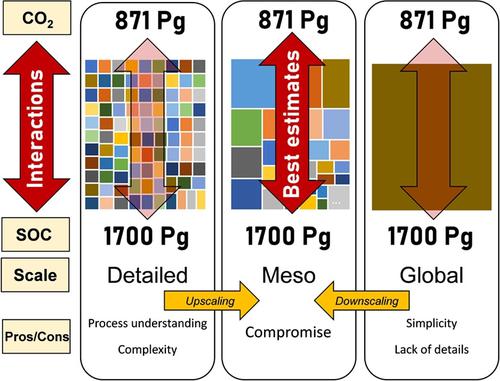当前位置:
X-MOL 学术
›
WIREs Clim. Chang.
›
论文详情
Our official English website, www.x-mol.net, welcomes your
feedback! (Note: you will need to create a separate account there.)
Global soil organic carbon–climate interactions: Why scales matter
WIREs Climate Change ( IF 9.4 ) Pub Date : 2022-06-02 , DOI: 10.1002/wcc.780 Hermann F. Jungkunst 1 , Jan Göpel 1 , Thomas Horvath 2 , Simone Ott 3 , Melanie Brunn 1
WIREs Climate Change ( IF 9.4 ) Pub Date : 2022-06-02 , DOI: 10.1002/wcc.780 Hermann F. Jungkunst 1 , Jan Göpel 1 , Thomas Horvath 2 , Simone Ott 3 , Melanie Brunn 1
Affiliation

|
Soil organic carbon (SOC) holds the largest terrestrial carbon stock because of soil conditions and processes that favor soil carbon persistence. Vulnerable to climate change, SOC may cross a tipping point toward liberating carbon-based greenhouse gases, implying massive self-amplifying SOC- climate interactions. Estimates of SOC persistence are challenging as we still lack broad mechanistic insights. Upscaling mechanistic details from small to larger scales is challenging because the driving factors are not available at the needed resolution. Downscaling is problematic as many modeling studies point to the highest uncertainties deriving from the SOC response to climate change, while models themselves have difficulties in replicating contemporary soil properties and dynamics. To bridge the problems of scaling, strict process orientation seems adequate. Holdridge Life Zones (HLZ) classification, as one example, is a climate classification framework at a mesoscale that provides a descriptive approach to facilitate the identification of potential hotspots and coldspots of SOC-climate interaction. Establishing coordinated experiments across all HLZ, but also including multiple global change drivers, has the potential to advance our understanding of general principles regulating SOC-climate interaction and SOC persistence. Therefore, regionally tailored solutions for both experiments and modeling are urgently needed and can lead to better management of soil and the ecosystem services provided. Improving “translations” from the scales relevant for process understanding to the scales of decision-making is key to good management and to predict the fate of our largest terrestrial carbon stock.
中文翻译:

全球土壤有机碳-气候相互作用:为什么尺度很重要
由于土壤条件和过程有利于土壤碳的持久性,土壤有机碳 (SOC) 拥有最大的陆地碳储量。由于易受气候变化的影响,SOC 可能会跨过释放基于碳的温室气体的临界点,这意味着大规模的自我放大 SOC 与气候的相互作用。由于我们仍然缺乏广泛的机制见解,因此对 SOC 持久性的估计具有挑战性。将机械细节从小尺度升级到大尺度具有挑战性,因为驱动因素在所需的分辨率下不可用。缩小尺度是有问题的,因为许多建模研究指出 SOC 对气候变化的响应具有最高的不确定性,而模型本身在复制当代土壤特性和动态方面存在困难。为了解决缩放问题,严格的过程导向似乎就足够了。例如,Holdridge Life Zones (HLZ) 分类是一种中尺度气候分类框架,它提供了一种描述性方法,有助于识别 SOC 与气候相互作用的潜在热点和冷点。在所有 HLZ 中建立协调实验,但也包括多个全球变化驱动因素,有可能促进我们对调节 SOC-气候相互作用和 SOC 持久性的一般原则的理解。因此,迫切需要针对实验和建模进行区域定制的解决方案,并可以更好地管理土壤和提供的生态系统服务。
更新日期:2022-06-02
中文翻译:

全球土壤有机碳-气候相互作用:为什么尺度很重要
由于土壤条件和过程有利于土壤碳的持久性,土壤有机碳 (SOC) 拥有最大的陆地碳储量。由于易受气候变化的影响,SOC 可能会跨过释放基于碳的温室气体的临界点,这意味着大规模的自我放大 SOC 与气候的相互作用。由于我们仍然缺乏广泛的机制见解,因此对 SOC 持久性的估计具有挑战性。将机械细节从小尺度升级到大尺度具有挑战性,因为驱动因素在所需的分辨率下不可用。缩小尺度是有问题的,因为许多建模研究指出 SOC 对气候变化的响应具有最高的不确定性,而模型本身在复制当代土壤特性和动态方面存在困难。为了解决缩放问题,严格的过程导向似乎就足够了。例如,Holdridge Life Zones (HLZ) 分类是一种中尺度气候分类框架,它提供了一种描述性方法,有助于识别 SOC 与气候相互作用的潜在热点和冷点。在所有 HLZ 中建立协调实验,但也包括多个全球变化驱动因素,有可能促进我们对调节 SOC-气候相互作用和 SOC 持久性的一般原则的理解。因此,迫切需要针对实验和建模进行区域定制的解决方案,并可以更好地管理土壤和提供的生态系统服务。











































 京公网安备 11010802027423号
京公网安备 11010802027423号